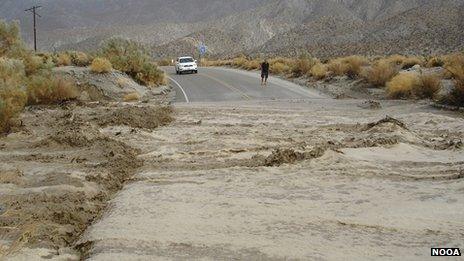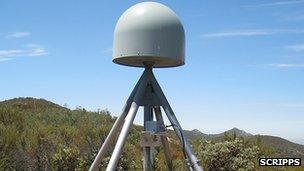California tests natural disaster early warning system
- Published

The system was used to forecast flash floods in California
An early warning system for earthquakes, tsunamis and floods is being trialled in the US.
Scientists are using GPS technology and other sensors to detect the impending threat of natural disasters.
The network is installed in Southern California and has already helped scientists to alert emergency services to the risk of flash floods.
Yehuda Bock from the Scripps Institute of Oceanography said: "This can help to mitigate threats to public safety."
And added: "It means real-time information can be made available."
Ground motion
The minutes and even seconds before a natural disaster strikes are crucial.
Early warning systems can help emergency services to prepare and respond more effectively and can provide vital information for the public.
In California, researchers have been testing a prototype network for a range of hazards.
The system builds on existing networks of GPS stations, which use satellite technology to make very precise measurements of any ground movement.
On these, they have installed seismic sensors and other instruments that can track changes in weather conditions.
Dr Bock said: "By combining the data from the GPS with the data from these other sensors, we can measure displacements that occur during an earthquake or another event."
He added that the system could detect the tremors that appear seconds before a large earthquake strikes, and accurately assess its magnitude and whether it is likely to generate a tsunami.
The GPS sensors and the meteorological instruments also help the team to monitor the water vapour in the air.
Dr Angelyn Moore, from Nasa's Jet Propulsion Laboratory, said: "It might be surprising that we are using GPS to monitor weather hazards, but GPS is a weather instrument.
"Fundamentally, a GPS station is measuring the time it takes a signal to travel from the GPS satellites to the receiving stations on the ground, and that travel time is modified by the amount of moisture in the air.
"Whenever we measure the position of a GPS station, we are also measuring the amount of water vapour above it."
Through this, the team is able to track in real time how air moisture is changing and whether heavy rain is likely.

GPS stations like this one are fitted with small seismic and meteorological sensors
In the summer, the researchers used the system to forecast rainfall in San Diego.
Traditionally, some of this data comes from weather balloons.
"But there are only two sites at the southern border of California and these are about 150 miles apart. And the weather balloon launches are also infrequent: in San Diego it's only every 12 hours," said Dr Moore.
"In between those many hours between the weather balloon launches, we were able to use the GPS to monitor how the water vapour was changing."
With this real-time information, the team was able to issue flash flood alerts.
Dr Moore added: "This was verified - there were quite a few reports of flooding."
The sensing technology is being combined with communication advances to make sure the information is widely distributed, fast.
Dr Mark Jackson, from the National Oceanic and Atmospheric Administration's National Weather Service, said: "When a forecaster presses that button to issue that warning, it then goes to the police or fire person that's responsible for taking action to protect life and property almost instantaneously.
"We also have the public who now on their smartphones can receive warnings directly that say there is a warning in effect for your area."
The team said the technology was inexpensive, and systems like it could be rolled out around the world.
The findings were presented at the recent American Geophysical Union Fall Meeting in San Francisco.
Follow Rebecca on Twitter, external
- Published17 May 2013
- Published9 July 2013
- Published25 April 2012
- Published23 March 2012